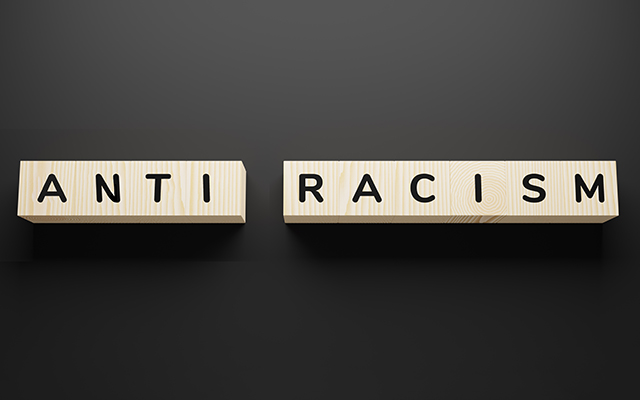Since George Floyd was killed by a Minneapolis police officer on May 25, 2020, many white people have been playing catch-up on their understanding of and complicity in racism. It seems that America could be on the verge, finally, of a real reckoning with its history of racial injustice. A Monmouth University poll released after Floyd’s death reports 76 percent of Americans believe racial and ethnic discrimination is a big problem in the United States, up from 51 percent in 2015.
As a white woman, I began to explore racism more deeply a year ago last February, after a series of blackface incidents occurred at the high school my daughters attend in suburban Minnesota. A friend suggested I read So You Want to Talk About Race by Ijeoma Oluo. At the time, I thought I was already “woke” and figured the book simply would confirm what I already believed: Racism was wrong. What else was there?
Instead, the book led me to a podcast, and then another book, deepening my understanding of how racism is embedded in our society. The more I learned, the more I realized I didn’t know.
Most eye-opening was how American institutions have enacted discriminatory policies that have oppressed people of color for generations. Entrenched policies in education, banking, housing, and healthcare still work against people of color, meaning even “good white people” support systemic racism through their own oblivious self-interest.
I began to see beyond the individual acts of racism in our school system to the larger opportunity-gaps for students of color, including discipline rates, test scores, and placement in advanced classes.
As someone who pursues healthy living personally and professionally, I realized something else: Standing up against racism is not only good for a better world; it’s good for personal health. From reading My Grandmother’s Hands by Resmaa Menakem, I learned how trauma from racism resides in our bodies (whether we’re white, Black, Indigenous, or people of color), as well as ways to recognize and settle my body’s reaction to racialized situations before engaging — which feels much better than fighting, fleeing, or freezing.
Victims of racism suffer disproportionately from a number of daunting health conditions — witness the racial disparities of COVID-19 infections and death rates — leading some to declare racism a public-health crisis. But, as I’m learning, white people aren’t left unscathed.
In his book Dying of Whiteness, Jonathan M. Metzl, MD, PhD, examines how racial resentment can lead to policies that undermine the health of white Americans. And public-policy expert Heather C. McGhee, author of the forthcoming The Sum of Us: What Racism Costs Everyone and How We Can Prosper Together, argues that racism undercuts everyone, including white people, on an economic level.
So being anti-racist — supporting actions and policies that oppose racism — is a critical part of both promoting and pursuing healthy living. These nine components are the foundation of an anti-racism practice, each playing a critical role in creating change.
1. Accept that racist thinking and policies have influenced your life.
“Racism is a system of advantage based on race,” says clinical psychologist Beverly Daniel Tatum, PhD, author of Why Are All the Black Kids Sitting Together in the Cafeteria? And Other Conversations About Race. “That system can operate and be perpetuated even by individuals who don’t hold negative attitudes about people of color.”
What’s more, says Tatum, allowing those systems to continue uninterrupted is racist, too. “Inaction in the face of racism allows it to continue, therefore the inaction is also racist,” she says. “Silence perpetuates the status quo.”
It was a harrowing realization: Through my previous inaction in my school district, I’d been supporting a system that unfairly disadvantaged people of color. What else had I missed by being oblivious? Did that mean I was racist?
“Racist” has become a hot-button word in our time, the most incendiary of accusations. But Ibram X. Kendi, founding director of the Boston University Center for Antiracist Research, urges us to consider the word as a label for actions, ideas, and policies. In this way, as Kendi suggests in his book, How to Be an Antiracist, we might be racist one minute and anti-racist the next.
As difficult as these realizations are to acknowledge, they’re also small victories in my work to be anti-racist. Kendi tells us that being anti-racist calls for improving our ability to check our own behavior. After all, if we can’t identify the problem, we will never be able to do the work to solve it. Having the insight and humility to call out your own racism is, in fact, one of the most important acts of being anti-racist.
2. Learn about white fragility.
This is still such a hard one for me. In my head, I am willing to get out of my own way, but the reality is that anti-racism work has challenged everything I thought I knew — especially about myself.
White fragility can manifest in many ways, from refusing to talk about racism to acting defensive. The phrase “all lives matter” is an example of this, because it cuts off the conversation about how Black lives are specifically under siege in the United States. It refuses to acknowledge the reality of our deeply racist society.
White fragility can also show up when you misstep (“I was just trying to help!”) or by centering yourself in the work.
An anti-racist practice means actively challenging yourself and what you believe. But, to be honest, that challenge is also what keeps me from checking out; this work answers the call to become a better person and feeds my affinity for overcoming difficult challenges.
My white fragility still trips me up, and although stumbling is frustrating, I get back up and keep going — often with the help of my learning circle of fellow white women who are also doing the work.
3. Acknowledge white privilege.
This is a phrase that raises the ire of people who don’t understand the context — it was made popular by an essay called “White Privilege: Unpacking the Invisible Knapsack,” by Peggy McIntosh. The privilege here doesn’t connote silver spoons or a lack of hard work; it simply means if you’re white, you haven’t suffered disadvantages due to the color of your skin. You have never had to think or operate differently in the world to avoid racist encounters.
I had a brush with my white privilege recently while catching up with a friend, who is Black. We were talking about our kids, and she was explaining that her sons wanted to ride their bikes this summer, but it made her nervous. As a cyclist myself, I worry about safety on the road, especially with so many distracted drivers. But that wasn’t her concern.
Then my brain moved on to COVID-19, and I thought, they should be at low risk riding with friends at a distance. But that wasn’t her worry.
It finally clicked when I realized her fear is that her young Black sons could suffer the same fate as Trayvon Martin or Ahmaud Arbery.
“When white people live, work, and go to school in predominantly white settings (as most white people in the United States do), they may simply think of themselves as being part of the racial norm,” Tatum explains, “perhaps even without conscious consideration of their white privilege: the systematically conferred advantages they receive simply because they are white.” I’m guilty of that.
4. Learn about implicit bias.
This concept is why we can’t always help inadvertently saying something racist or having a racist thought. According to the Kirwan Institute for the Study of Race and Ethnicity, “Implicit bias refers to the attitudes or stereotypes that affect our understanding, actions, and decisions in an unconscious manner.” Implicit biases are so embedded in our psyche that we don’t recognize them — versus the explicit bias some people exhibit that feels easy to condemn.
Tatum says this is why people often perceive themselves as “colorblind,” completely free of prejudice, and are unaware of their own assumptions about other racial groups. “Though the bias that results may not be conscious, the consequences — discriminatory decision-making in hiring, for example — are the same as if the racism was overt,” she says.
When I started doing racial-justice work, I read about how implicit bias worked in other people, but I didn’t yet grasp how implicit bias — buried in the entire population of white people, myself included — collectively fueled racism, more than any white-nationalist movement.
“It is hard to get stereotypes out of your head once you have learned them,” Tatum says, but she offers two strategies: repeated exposure to positive counter-stereotypic images and denying implicit biases the chance to operate — for example, removing names and any racially identifying information from job applications.
“Also, establishing clear norms for appropriate, nondiscriminatory behavior can help,” she adds. “When a situation is ambiguous, racial bias is more likely to emerge.”
5. Be aware of microaggressions.
When you aren’t aware that your words or actions can be racist, you could say or do something inadvertently degrading to a person of color. That is a microaggression.
“Where are you really from?” “Your name is so hard to pronounce, can I use a nickname?” “Can I touch your hair?” All of these questions dumped on people of color are a constant reminder of their otherness. Tatum says microaggressions often involve the projection of stereotypes, and they constantly loom as a potential source of stress.
Other examples of micro-aggressions include a group conversation where a person of color gets left out, a teacher who suggests to her Black student that an honors course will be too challenging, or the bank teller who hesitates to cash a check for a Black customer.
Often the white person inflicting the harm is oblivious. But microaggressions can have real consequences.
“Research has shown that the cumulative effect of microaggressions can result in anger and frustration, anxiety, depression, lowered self-esteem, physical symptoms, and shortened life expectancy,” Tatum says. Many experts have shown that this type of discrimination has real health effects and that this “death by a thousand cuts” is sickening and killing Black people at much higher rates than white people.
6. Develop authentic relationships with people of color.
White people often choose to live and work with other white people, which leads to other homogeneous settings for socializing, entertainment, and places of worship.
“People of color are not having the same experiences as white people,” Tatum says. “The racial-group membership of people of color impacts their daily lives — where they live and go to school, access to employment, the quality of healthcare received, and interactions with police.”
This can be hard to grasp until you interact with people of color on a regular basis. Those personal relationships can expand your own racial understanding because you are likely to replace what you thought you knew about people of color with what you actually know from firsthand experience.
Also, cultivating a relationship with a person of color brings you closer to that person’s lived experiences. You might be upset to read about a Black woman who was followed and watched suspiciously in a department store, but if you actually see this happen to your friend, you witness the harm in real time (and can call out the discrimination on her behalf if she wants your assistance), which makes a visceral difference.
It can take time to diversify your friendships, but while you’re doing that, you can still experience Black culture by diversifying your media. Rachel Cargle’s free 30-day #DoTheWork online course recommends exposing yourself to Black voices by reading books authored by people of color, watching movies and documentaries produced by people of color, and following people of color on social media.
7. Understand racism from the perspective of people of color.
Even though many white people are segregated from people of color, they often talk about racism as if they were in a position of authority, says Paul Kivel, activist and author of Uprooting Racism: How White People Can Work for Racial Justice.
“Part of the misinformation is the belief that white people carry the truth; we have done everything of significance, we’re the leaders and heroes of everybody’s stories. This leads to a sense of entitlement and superiority,” Kivel says. “And that makes it hard to listen with an open heart and deep respect for people of color talking about their lives.”
Even if you do have Black friends or coworkers, don’t just lean on them for understanding. Do your homework first. “There is so much rich literature, poetry, and music, and so many resources, we should not burden the closest person of color around to do the work for us,” Kivel says.
Just take a look at the New York Times bestseller list — you’ll find a number of books worthy of a read, including Kendi’s How to Be an Antiracist, as well as Between the World and Me by Ta-Nehisi Coates and Me and White Supremacy by Layla F. Saad. There are many podcasts that provide a deep dive into the history of how race and racism evolved, like Seeing White, 1619, and Code Switch.
8. Have more conversations about race.
This used to be taboo, right? If you’re white, you’ve probably been conditioned to look beyond the color of people’s skin. And if you don’t “see color,” then you don’t see the problems that people of color experience, and — poof! — what’s there to talk about?
A lot, according to Marnita Schroedl, who has brought some 80,000 people from across the globe into conversations since she founded her Minneapolis-based nonprofit, Marnita’s Table, in 2005. Her experience in the foster system and growing up biracial — often confronting hate-filled rhetoric and entrenched public policies designed to limit access and opportunity — led her to believe that an authentic welcome was the first trust-building step on the path toward social change.
Coming to the “Table” combines breaking bread, bridging differences, sharing power, and building civic muscle. I’ve been to Marnita’s Table twice and was awestruck by the process, called Intentional Social Interaction. Walking into a room of several hundred diverse people I didn’t know felt daunting, but spending the evening sharing and eating together was magical. (Now they’ve also created Digital Intentional Social Interaction so that even during COVID-19, attendees can have a seat at the virtual table.)
“We need community to heal from trauma,” Schroedl says, adding that abusers suffer from trauma as well. “I hope to accomplish a seismic change that encourages people to show up better and different.”
Kivel says there are a lot of white people who want to make a difference, and those are the people we should be talking to. “But we’re not missionaries, we’re not proselytizing to save white people,” he says. “We need to be genuinely engaged, listen to concerns, and understand we all have mutual interests in transforming our society.”
9. Stand up against racism in your community.
It’s tempting to stay silent when racism comes up in your social circle, and easy to believe that your voice wouldn’t change much. But silence in these situations only raises everyone’s tolerance for racism.
What’s more, pointing it out builds the vocabulary for talking about racism, helps everyone in the room take stock of their own complacency, and normalizes the act of calling out racism. Speaking up in your own community is easier said than done. As a typical conflict-avoider, I don’t want to make people uncomfortable. But staying silent puts the comfort of white people above the oppression of people of color.
When you’re in a more diverse group, “standing up” requires listening to people of color. “We’re used to being in leadership and seeing white people in leadership,” Kivel says, adding that when it comes to racial justice, we’re not the heroes, and we don’t have all the answers. “We need to turn to those who do and follow their leadership.”
Kivel adds that people of color who are leading racial-justice struggles are knowledgeable and strategic — they know how the system works because they experience it every day and are the survivors of it. White people can’t claim that experience.
“To show up as an ally is to be humble,” he explains. “We need to follow so we can show up in useful, efficient, and sustained ways, and work together collectively for all forms of justice.”
What’s more, Kivel says, we need to remember that being an ally is a practice — not an identity. “It’s how we show up every day,” he says.
Striving to be anti-racist, like striving to be healthy, is now a lens through which I see the world. I use it to inform my choices and actions. Just like my daily yoga practice, I practice anti-racism — and some days I can hit poses confidently, while other days I fall out of them. My attention and humility is the way forward.
Considerations for your Anti-Racism Practice
To better stand up against racism in our daily lives, clinical psychologist Beverly Daniel Tatum, PhD, author of Why Are All the Black Kids Sitting Together in the Cafeteria? And Other Conversations About Race, invites us to consider the ways we move in the world, to identify our strengths, and to use them. She suggests asking yourself these questions:
- Whose lives do you affect and how? What power and authority do you wield in the world? What meetings do you attend? Who do you talk to in the course of a day?
- If you are a parent, what conversations have you had with your children about these issues? What books are sitting on their bookshelves? Do you know what discussions are taking place at your child’s school?
- If you are a teacher, what dialogue is taking place in your classroom? Regardless of your subject matter, there are ways to engage young people in critical thinking about racism that is relevant.
- If you like to write, have you written any letters to the editor? Have you written to broadcasters protesting programming that perpetuates racial stereotypes?
- If you are an extrovert, have you used your people skills to gather others together for dialogue about racism?
- If you are on a sports team, what language and behavior do you model in the locker room?
- If you are a board member, what questions do you raise at the meetings? Who sits on the board with you? What values and perspectives are represented there?
- If you are an employer, who is missing from your work force? What are you doing about it?




This Post Has 0 Comments